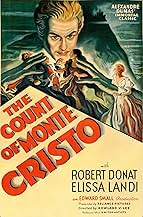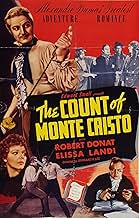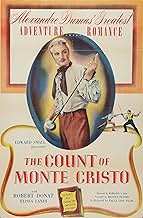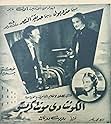IMDb-BEWERTUNG
7,4/10
3591
IHRE BEWERTUNG
Füge eine Handlung in deiner Sprache hinzuAfter greedy men have Edmond Dantes unjustly imprisoned for 20 years for innocently delivering a letter entrusted to him, he escapes to get his revenge on them.After greedy men have Edmond Dantes unjustly imprisoned for 20 years for innocently delivering a letter entrusted to him, he escapes to get his revenge on them.After greedy men have Edmond Dantes unjustly imprisoned for 20 years for innocently delivering a letter entrusted to him, he escapes to get his revenge on them.
- Auszeichnungen
- 3 wins total
Empfohlene Bewertungen
Delightful film of the classic stage warhorse, a bit creaky and slow starting, but with cumulative power sustained by the subtle yet vivid characterizations. Each principal has a uniquely nuanced personality, brought forth by gesture and language -- something sorely lacking in today's 90 percent trash. NOTE FOR CINASTES: I never fully appreciated the comic outrages of Jame's Whale's use of the Hermit in Bride of Frankenstein until I saw the prototype, created here by the same actor, O. P. Heggie. The Hermit in "Bride" is a gleeful, unabashed parody of Faria, even in the crescendo of music that mimics the "Ave Maria" in the Whale picture. I'm sure Whale wondered if his in-joke would be caught, and by how many. See the picture and you'll understand.
There's a sentence but no trial to make your case, those you trust have had you interred at great haste, you've lost your love and future wife, must live in conflict and in strife, to wither in a cell while being laid to waste. But there's hope when you find out you're not alone, as a pair you set to work removing stone, excavating day and night, searching for the sight of light, until a tragedy, and your future is resewn. You inherit your dead partners wealth and riches, it allows you to acquire the finest britches, plus a title and some land, now revenge can be well planned, all because of nimble hands and threaded stitches.
A perpetually enduring tale, magnificently performed and presented, albeit with poetic license.
A perpetually enduring tale, magnificently performed and presented, albeit with poetic license.
Alexandre Dumas' novel is a classic, and of a number of film adaptations, of which are a mixed bunch in terms of success, it's the 1934 film starring Robert Donat that I consider the best version. Maybe the editing in the escape scene is a little plodding, other than that the film is very handsomely mounted with lavish period detail and beautiful cinematography. Alfred Newman's score is suitably rousing, the story is the very definition of thrilling and never stops maintaining interest and the script is very literate and sometimes witty. The characters all engage, with the leads likable and easy to identify with and the villains suitably repellent. The swash-buckling also is never clumsy and Rowland V Lee directs beautifully. Robert Donat gives a performance that for me has only been bettered by the title role in Goodbye Mr Chips, expertly progressing from naive to calculating. Elissa Landi matches him in a sympathetic and moving performance, and Raymond Walburn is a sly Danglers, but other than Donat the other best performance is the sharp Villefort of Louis Calhern. Sidney Blackmer's Mondego is also splendidly characterised, and OP Heggie delights in a role that will remind one of the hermit in Bride of Frankenstein. Overall, wholly satisfying and definitely recommended. 9/10 Bethany Cox
Robert Donat was a fine actor who went on to win our hearts with Greer Garson in Goodbye, Mr. Chips. People often forget that he was slated to play the lead in the Sabatini novel, Captain Blood, which went to Errol Flynn, thus establishing his career and mark on Hollywood (and what a mark!). Donat, according to his biographers, detested Hollywood and made several films in Great Britain. His role in the Hitchcock 39 steps is legend. This film, which is a slightly more faithful adaptation of the Dumas book than the one only recently (1/02) released, is superior to its predecessor in several ways. Alas, the other reviewer here is likely too young to have seen in its original B/W but it is a fine film. the lovely Elissa Landi plays Mercedes and Sidney Blackmer, Donat's betrayer. The character actor, O.P. Heggie plays the priest and fellow prisoner of Dantes. Veteran Louis Calhern, here youthful, plays the other betrayer and villain. There's no video or DVD, so if this shows up on the late show, by all means, check it out.
This should be a classic. It is a superb motion picture. It has a brilliant cast. An excellent interpretation of what the author of the book wrote. The director and producer was of the top class.
Wusstest du schon
- WissenswertesThis is the version that "V" in V wie Vendetta (2005) claimed to be his favorite film.
- PatzerDuring the fencing duel between Dantes and Mondego, in one brief shot near the end Sidney Blackmer holds his sword in his left hand instead of his right, which he does in the rest of the scene. This was obviously a shown in reverse as is often done to add footage.
- Zitate
[last lines]
Albert de Mondego: [to Dantes and Mercedes who are up in the branches of a tree] Can we come up?
Edmond Dantes: Find your own tree.
- Crazy CreditsPrologue: "1815--Napoleon had achieved an empire and lost it again. Exhausted by years of revolution and war, France strove to make peace with her neighbors under the rule of King Louis XVIII....while the "Little Corporal," now in exile, reigned over only a few square miles of land--Elba. But the memory of his colorful career still endeared him to the hearts of the people, and his loyal followers were actively conspiring to return him to power."
- Alternative VersionenAlso available in a computer-colorized version.
- VerbindungenFeatured in MGM/UA Home Video Laserdisc Sampler (1990)
Top-Auswahl
Melde dich zum Bewerten an und greife auf die Watchlist für personalisierte Empfehlungen zu.
- How long is The Count of Monte Cristo?Powered by Alexa
Details
- Erscheinungsdatum
- Herkunftsland
- Offizieller Standort
- Sprachen
- Auch bekannt als
- Der Graf von Monte Christo
- Drehorte
- Produktionsfirma
- Weitere beteiligte Unternehmen bei IMDbPro anzeigen
Box Office
- Bruttoertrag in den USA und Kanada
- 3.270.000 $
- Laufzeit1 Stunde 53 Minuten
- Farbe
- Seitenverhältnis
- 1.37 : 1
Zu dieser Seite beitragen
Bearbeitung vorschlagen oder fehlenden Inhalt hinzufügen





































